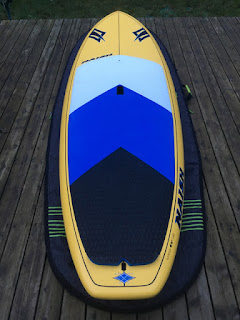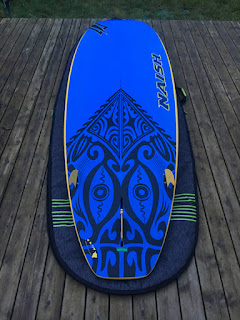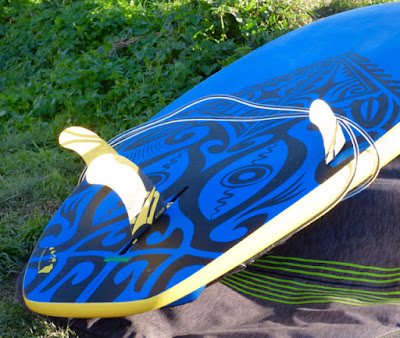A step down Surf SUP to force progression in waves.
About Nash
Founded in 1979 Naish have a history in Windsurfing, Kiteboarding and more recently in the world of SUP with their sponsored athletes including Casper Steinfath and Kai Lenny showing us all how best to use their distinctive yellow boards.
The Mana
The Mana is a great looking board, mine is a 2016 model, the 2017 has the same shape and dimensions but with a different deck pad and graphics. Trademark Naish bright yellow with black pin stripes marking out the stringer and running around the outline of the nose. Underfoot is a bold white, blue and black multi textured EVA pad with a kick at the tail covering 2/3 of the deck. A single leash point is in the middle of the rounded square tail. The recessed handle is perfectly placed in the centre of the board and has a deep ledge making carrying this board any distance comfortable.
 |
| Simple, bold graphics and deck pad on the 2016 Mana |
Underneath the base is finished with a beautiful deep blue with a Hawaiian style logo in black. In one the corner is a small graphic of the Hawaiian Islands, the birth place of Naish the brand, in yellow of course.
 |
| Spot the Hawaiian Islands, bottom left. |
The Naish branded fins are ok, not basic plastic but not all singing all dancing top end fins either. Fin set up is 2 + 1, supplied are a 6.5” centre fin and two FCS side bites.
From the Naish website
The Mana 9'5" GTW/GS features an exaggerated wave design for riders who want both stability and optimum performance in medium to small size surf. It has an exaggerated tail rocker, V bottom and soft rails to make turning on a wave incredibly easy.
The finish of the board I bought from Reactive Watersports in Plymouth was excellent. She certainly looks the part and with the addition of a 9' leash was ready to hit the water.
Board Dimensions
Length 9’5” / 287cm
Width 32” / 81.3cm
Thickness 4.75” / 12cm
Volume 163l
Weight 10.8 kg
Rider Dimensions
Height 6'3" / 193cm
Weight 220lbs / 100 kg
Pushing the envelope
I’ll be completely honest, over estimating my ability to surf lead to the purchase of the Naish. My first Surf SUP, an 11’2” Widepoint that you can read about here, was so easy to get onto a wave that I wanted more. And as a result my first few outings on my new yellow friend were frustrating, swimming lessons with a large float. Naively I’d thought that a shorter board with the same width would be as easy to stand on and reducing the length would make it easier to move about on a wave.
If you don’t know already, that’s nonsense. And it took me a while to work out why.
It’s not just width that gives stability. The length of a board contributes a heck of a lot to the stand-ability of a surf SUP, there are dozens of well written articles available that explain why and I’d recommend firing up Google if you’re thinking of getting a smaller board to have more fun in the surf.
Every attempt to get to grips with her had been at a spot I’ve used many times with my learner board, a quiet bit of a popular spot where you can just walk to the beach and paddle into something rideable. And that really suited the bigger board, usually messy and always with a secondary swell ready to unsettle the inexperienced. All that would be ironed out by the bulk of HMS Widepoint and all perfect to taint my impressions of the MV Naish. Lets just say that at first paddling the Mana, even on flat water, was a challenge.
And that was frustrating.
Knowing that fins make a huge difference to boards, including their stability, I tried swapping things around, even trying a relatively huge 9” centre fin in it before putting her away for a few weeks and reverting the the relative ease of a bigger board. She had me beat.
 |
| 2 + 1 fin set up, 6.5" centre fin |
Try, try and try again
Every time I got a board out of the garage there she was, taunting me. Until early one Sunday morning I could no longer ignore the bright yellow board and put her in the van.
Different place + better conditions = different experience.
One big benefit of surf SUPs is that you can get to locations less paddled. A 1km paddle in with a lazy cross swell was a good warm-up. In an effort to learn how to handle the Mana I’d gone back to the fins supplied acknowledging that Naish know a lot more about this than I do. To my buddies amusement I only swam once, an improvement over previous outings. Worth it though to get to an empty beach break with 2’ of cleanish, regular waves.
Of course I messed up the first one.
Expectation of failure resulted in a missed wave, but I only just missed it. Close enough raise confidence a little. Paddle out a bit further, reposition and commit to the next one. And …
Woah! Surfing happened.
Woah! Surfing happened.
2 hours later and we’re paddling back with massive smiles, our session curtailed by family commitments. That single session doing more to progress my surfing prowess than any number of sessions on an easy board. At one point I'm sure that I managed stumble towards the nose, no stylish cross stepping even my imagination isn't that good but my foot was definitely well in front of the deck pad before I stumbled back again. There was even some spray thrown up during turns, accidentally at first but repeatable. Noting that would ever make a YouTube video but more than enough to raise a smile.
Stepping Down
Moving to a smaller board was a bigger challenge than I’d anticipated and after the initial adjustment period it seems to be working. The Mana is actually a stable platform for the larger paddler that is nimble and responsive when used confidently. Changes in direction are easy either with the paddle or changes in body position and good footwork. It’s easy to engage those standard fins and engage those 'soft' rails. With the addition of some grip near the nose (I've used Hexatraction from RSPro) it’s perfectly possible to get forward and attempt to look like a long boarder for a more chilled out ride.
A rewarding ride for the inexperienced and a platform that I’ll be using for some time to improve my surfing.

